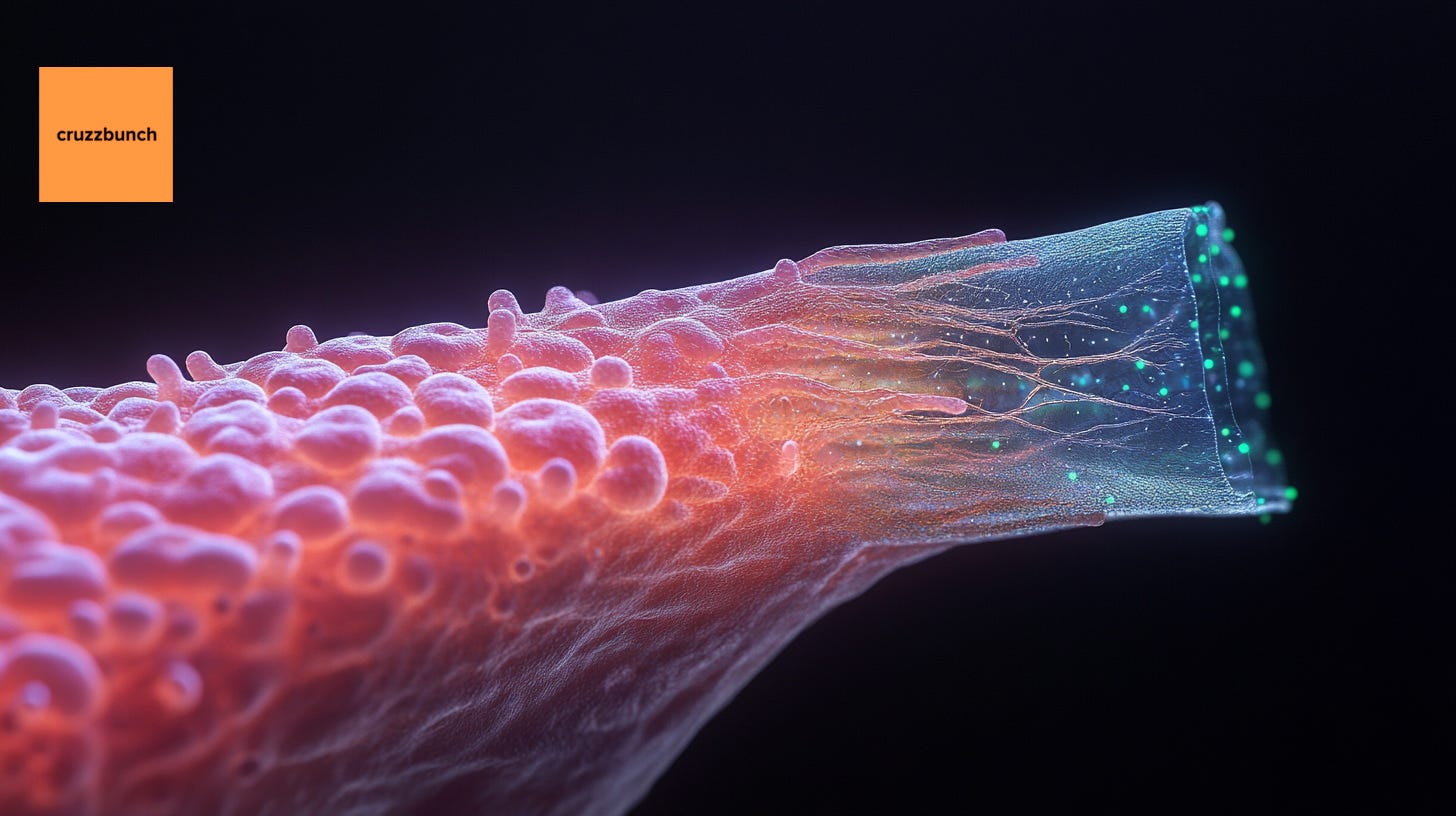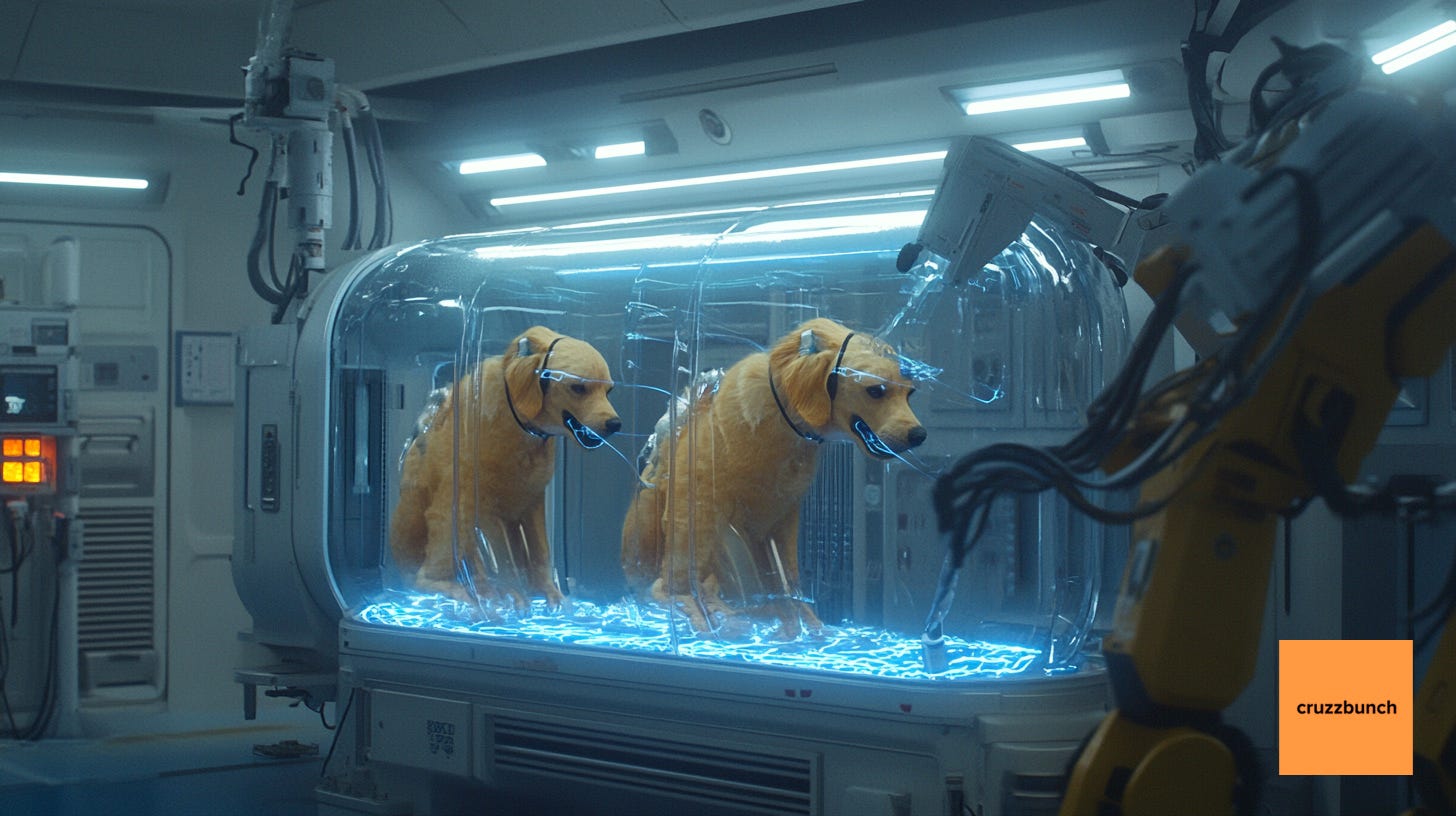Jake Explains....The Science Behind Digital Consciousness Cutesy's Quantum Pet Revival
by Jake Cruzzle, CruzzBunch co-founder and co-CEO
In Cutesy's state-of-the-art Palo Alto quantum lab, they are accomplishing what was once thought philosophically impossible: preserving and transferring the consciousness of animals. The golden retriever Max, who arrived three weeks ago with advanced lymphoma, is about to have his entire consciousness - memories, personality, every tail wag and learned trick - mapped and prepared for transfer into a healthy cloned body. And I'm here to witness it.
Through polarized glass, I watch as their quantum tunneling microscope maps Max's neural pathways at the subatomic level. The microscope array combines quantum entanglement sensors with ultra-precise magnetic resonance imaging, allowing it to capture both the physical structure and quantum states of individual neurons without disrupting their function - a feat that previously violated fundamental principles of quantum measurement.
The company's breakthrough is revolutionary: consciousness, they've discovered, exists not just in the physical connections between neurons, but in quantum-level patterns that span multiple scales of brain activity simultaneously. By developing technology that can observe these patterns without collapsing their quantum states, Cutesy can effectively "read" the entire neural symphony of a living mind - from the broadest patterns of thought down to the quantum dance of individual neurons.
After three months studying their consciousness preservation technology, I'm here to explain how this remarkable system works. Cutesy's approach revolves around three integrated technologies that work together to preserve and transfer consciousness:
QUANTUM NEURAL MAPPING: Using modified quantum tunneling microscopes, they capture brain structure and quantum states at 0.1 nanometer resolution
DIGITAL CONSCIOUSNESS MODELING: Their AI system creates a "living digital twin" that preserves both classical and quantum patterns of consciousness
BIOLOGICAL INTEGRATION: The digital consciousness is carefully transferred into a cloned body through quantum neural bridging
QUANTUM NEURAL MAPPING
Watching Max on the scanning platform, I can hardly believe this is the same dog that arrived three weeks ago with advanced lymphoma. His original family, the Chans, brought him to Cutesy as a last resort. Now he rests peacefully under the quantum tunneling microscope array, his neural patterns being captured at 0.1 nanometers resolution. Unlike traditional brain mapping that only captures synaptic connections, Cutesy's system records quantum states within individual neurons, preserving what they believe is the essence of Max's consciousness - every memory of playing fetch, every moment of recognition when his family comes home.
The real innovation isn't just the resolution - it's the system's ability to maintain quantum coherence during observation. Through a process they call quantum threading, they track neural quantum states without causing wave function collapse. As I watch the scan progress, tiny lights flash across the holographic display, mapping not just Max's brain structure, but what Cutesy believes is his very essence.
DIGITAL CONSCIOUSNESS MODELING
The quantum data from Max's scan flows into Cutesy's neural simulation environment, where their consciousness coherence algorithms create his digital twin. What's fascinating isn't just the technical sophistication - it's watching Max's personality emerge in the simulation. When they run test scenarios, the digital model reacts exactly as Max does: the same head tilt when he hears his name, the same excitement when shown his favorite toy, even the same slight limp from an old injury that never quite healed.
Rather than trying to perfectly replicate every neural connection, their system identifies and preserves consciousness vectors - fundamental patterns that persist across both quantum and classical domains. During Max's modeling phase, I watched as the system reconstructed seven years of memories and behaviors, building what they call his quantum-probabilistic personality matrix.
BIOLOGICAL INTEGRATION
The final phase might be the most emotionally striking. Max's digital consciousness is being transferred into a cloned body, genetically identical but free of cancer. Using targeted electromagnetic fields guided by quantum feedback loops, they gradually align the clone's neural patterns with Max's digital model. The process takes three weeks, but watching the new body slowly awaken with Max's personality intact is remarkable. Yesterday, I witnessed the moment he first recognized Sarah Chen, his owner - the tail wag and excited bark were identical to his original self.
RESULTS AND IMPLICATIONS
The behavioral consistency in Max's case matches what I've seen across dozens of transferred pets. Using standardized animal cognition tests, his results show:
Core memory retention rates of 96%
Personality trait preservation of 92%
Novel situation response matching at 88%
Learning pattern continuation at 94%
Most convincingly, Max still remembers all his old tricks, maintains his unique preferences (including his inexplicable fear of orange balloons), and continues to show the same devoted personality that made him such a beloved family member. When I visited the Chans last week, Max greeted me exactly as he had in his original body - with cautious curiosity followed by enthusiastic acceptance.
As I watch Max playing in Cutesy's recovery garden, chasing the same tennis ball with the same boundless energy, I can't help but wonder: how much of who we are exists beyond our physical form? Max's case suggests the answer might be: everything that matters.
"Jake Explains" is CruzzBunch's cornerstone technical series, where co-founder Jake Cruzzle unpacks the groundbreaking technology reshaping our world. With a gift for making complex systems understandable, Jake has previously illuminated the elegant architecture behind Tank Think's Joel AI and demonstrated how FastLaw's automated judgment systems achieve their remarkable accuracy. Each breakdown combines rigorous technical analysis with unprecedented access to the technology in question, giving readers a clear window into the innovations driving tomorrow's breakthroughs.





